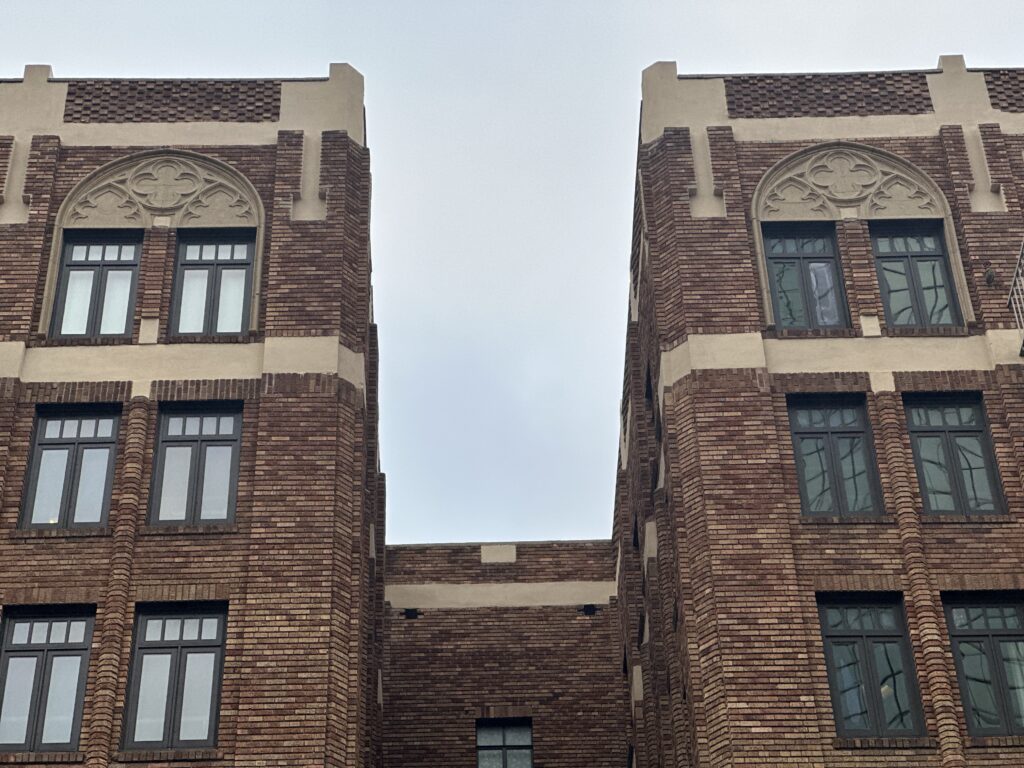No products in the cart.
Landmarks
A Repurposed Legend
The Pickwick/Sofia Hotel
1926
150 W. Broadway
Architecture: William Peugh
Architectural Style: Gothic Revival
Most travelers today look for the fastest way to get to their destination. Gone are the days of leisurely travel with occasional stops along the way for rest or local exploration. Although train travel is showing some signs of revival, bus travel is strictly for convenience and lower fares. Even though they are not as prevalent as during the 1930s, 40s and 50s, the “golden age of bus travel,” in today’s fast-paced world, motor coaches still continue to play a crucial role in the travel landscape. Offering convenience and cost-effectiveness, they remain a popular choice for group travel and sightseeing tours.
In the early to mid 1920s, Pickwick Stage Lines was one of the biggest transportation enterprises in the country. They particularly gained popularity with the introduction of the Model 719 motor coach, which featured the now recognizable flat front, underfloor luggage compartment and rear engine. A later model, the 793, even added air-conditioning. Additionally, Pickwick Stages, as it was called, opened hotels at major stops nationwide to serve as waypoints or places tourists might be interested in exploring. Pickwick also opened a radio station in each of its major hotels, and KGB, San Diego’s first radio station, was ultimately housed in the San Diego Pickwick. This is also where radio, and eventually TV personality, Art Linkletter got his start.
This Pickwick Hotel opened its doors in San Diego at First and Broadway in May of 1927. The first hotel in San Diego to be built with “en suite” bathrooms, its marketing slogan was “A Room and a Bath for Two and a Half.” The company also debuted a special venue known as “The Piccadilly Lounge,” which entertained visitors and locals alike for many generations.
This beautiful Gothic Revival edifice featured a crenellated roofline with terra cotta embellishments, a facade of variegated brown brick, and raised cement decorative features. Traditional double sashed windows with elaborate curved and embellished cornices provided additional natural light and ventilation. Moorish arches and architectural elements were featured on the main floor.
Unfortunately, the Pickwick Stage Lines became overextended when the Depression hit, and in order to mitigate financial difficulties, it leased the adjacent bus terminal and the first two floors of the hotel to the Greyhound Lines. However, the hotel retained its Pickwick name, and during WWII, service personnel were housed in the Pickwick.
After the war, the San Diego City Council ordered the removal of some of the architectural elements on the side of the building due to fear of injury or accident. Earthquakes were a new topic of great concern on the home front!
Although it experienced many years of service and popularity, by the end of the 20th century the Pickwick was showing the signs of significant weathering. It was forced to close, but received a reprieve from newly formed Pickwick Partners headed by Harki Parekh and Ken Winslow. They were determined to restore the hotel to its former grandeur. After nearly two decades, the Pickwick, now re-named the Sofia, opened in 2006. A member of Historic Hotels of America since 2008, this enduring old beauty is courting the possibility of a second golden age of hospitality and historic significance.
Sandee is the Historian/Lead Tour Guide for the Gaslamp Quarter Historical Foundation.
She can be reached at [email protected].

